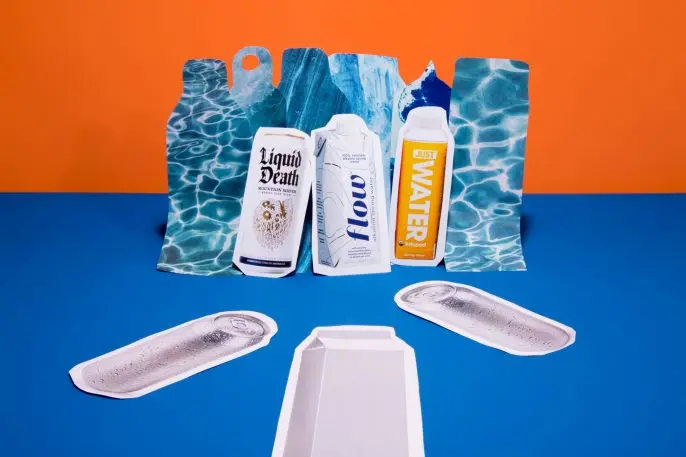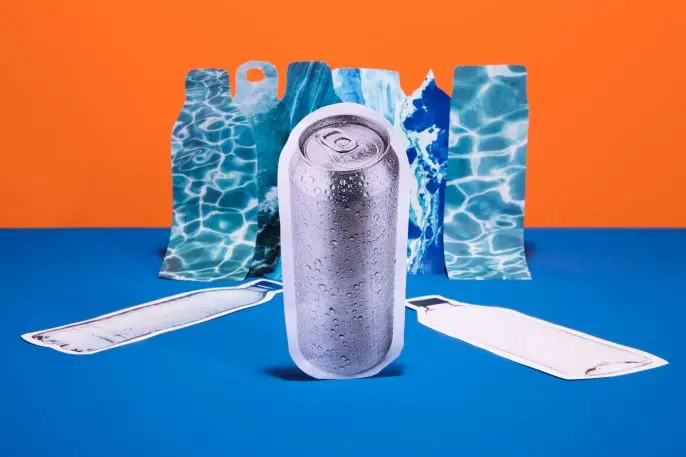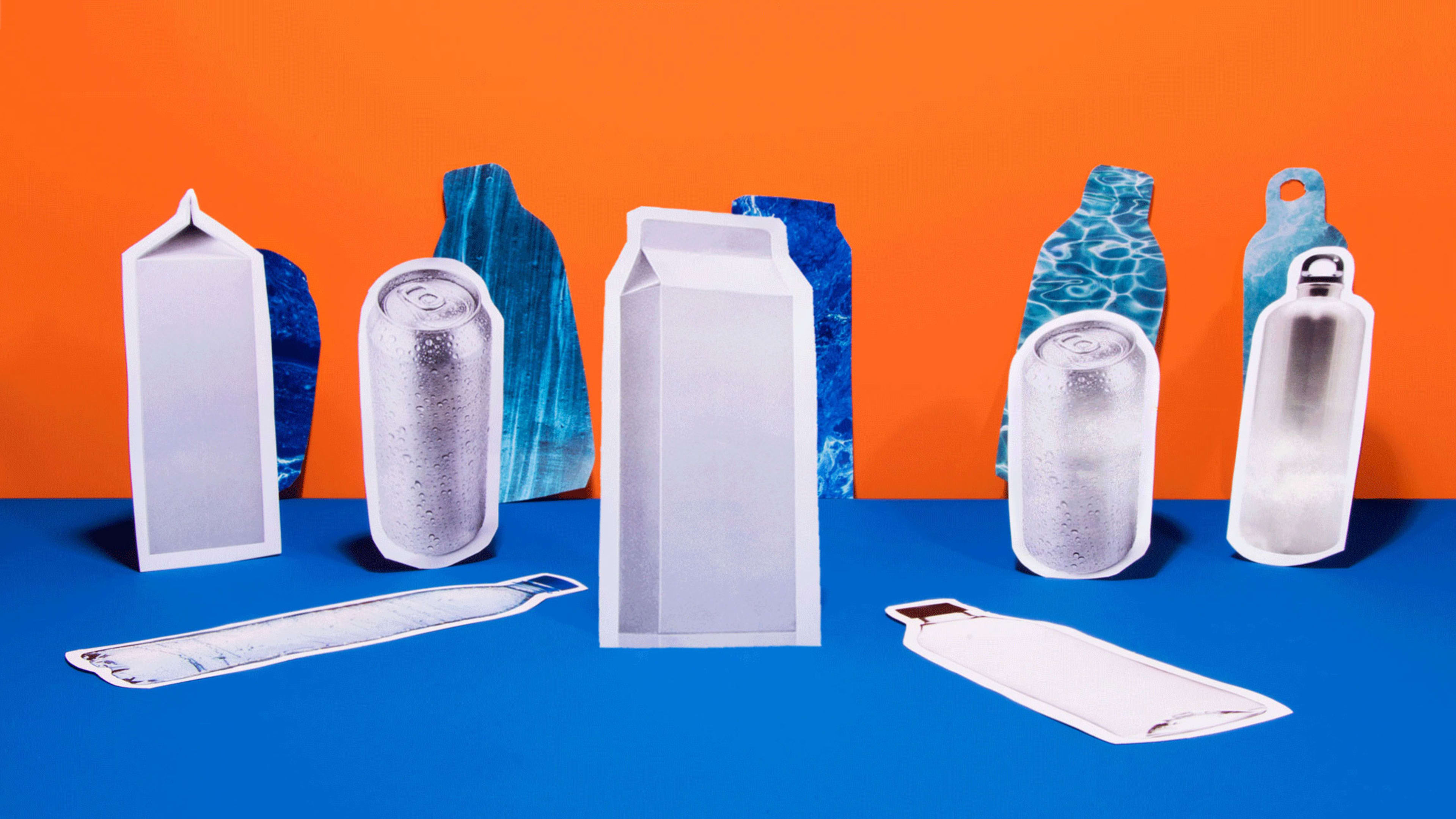About two and a half hours northwest of Toronto, near Lake Huron, a small wooden shanty—about eight feet long and four feet wide—stands at the edge of a forest, near a spring lake. The only hint that this is anything other than a rustic toolshed is the gleaming silver, 38,000-liter tanker-trailer parked next to it.
Ah, but pop the two padlocks off the door and step inside, and you’ll see an eight-inch-diameter pipe rising two feet from the ground that’s connected to two filters, a UV treatment reactor, and a hose. “You don’t need more than this,” says Mike Bajurny, operations officer and cofounder of Flow, a brand of naturally alkaline mineral spring water that is trucked from here to Toronto, packaged in Tetra Pak, and sold internationally at a price of $20 for 12 500-milliliter bottles. “We wanted to keep it as unchanged as possible. That’s why we decided not even to run electricity lines in. Keep it completely off the grid.”
This propane-and solar-powered shed, off a road leading to an Ontario town called Mildmay (population 1,219), is among the last places on earth one might associate with Gwyneth Paltrow. But in June, Paltrow’s wellness company, Goop, announced that Flow will be its exclusive water brand for the rest of the year, and Paltrow is starring in its ad campaign.
“We all know hydration is one of the core tenets of great health and glowing skin,” Paltrow said in a statement announcing the deal, “but the convenience of a water bottle is usually outweighed by its environmental ramifications. Flow is changing the game with a spring water that is naturally alkaline—nothing added—in 100% recyclable packaging. The pack is made from sustainably sourced fibers and even has a plant-based cap crafted from sugarcane.”
https://youtu.be/nX05R986WzU
Within 36 hours of the announcement, Flow earned 350 million free media impressions globally, more than the five-year-old startup had attracted in its history, and a little-known water brand for yoga moms formally entered the new wave of companies transforming the nearly $20 billion American bottled-water market.
Not that long ago, bottled water was pretty simple. Still or sparkling. Filtered or mineral. Over the past decade, however, as we’ve all (statistically) been drinking less soda, the field has exploded. According to the market researcher Euromonitor, during the past five years, bottled water has accounted for 96% of the volume growth in global soft drinks, driven by a new emphasis on flavors (Bai), sourcing (Kona Deep), packaging (Liquid Death), and such functional and wellness-focused ingredients as protein (Protein20), caffeine (Avitae), CBD (Sweet Reason), and soluble fiber (Hellowater).
Water, then, has become a colorless, flavorless canvas on which to project societal trends—and tease cures for everything from fatigue to constipation to boredom. “People want added functional benefits without sugar,” says Flow cofounder and CEO Nicholas Reichenbach, who grew up in Mildmay. “They don’t want to drink Gatorade, but they want Gatorade, right?” To paraphrase comedian Jim Gaffigan, water’s new wave is about selling us something even more watery than water.
https://youtu.be/zrfqKMTPvPs
And ideally not killing the planet along the way.
Casting for a plastic replacement
As Reichenbach was launching Flow, his wife, Tammy Eckenswiller, a former VP of brand creative at fashion company Rebecca Minkoff, asked him to test the mineral content and pH of the spring water, which flows 47 feet underground below a limestone shelf on a patch of land that Reichenbach’s great-grandfather originally purchased to use as a fishing retreat.
“Sure enough, the tests came back, and not only is it the highest-quality, naturally-occurring alkaline water in the market, with a pH of 8.1 at the source and jam-packed full of calcium bicarbonates; it also came back with even more natural electrolytes than Smartwater and other leading electrolyte waters,” Reichenbach says. “That’s when we started building our profile, that this all needs to be focused around the wellness woman.”
Reichenbach credits Coca-Cola’s Smartwater with popularizing the idea of “functional water” (i.e., alkaline water with electrolytes), but Flow’s target audience isn’t only interested in natural alkalinity. “They also don’t like plastic,” he says. “That was a big thing with us: Let’s get rid of the single-use plastic bottle and go into a much more environmentally sustainable package.”

More from Fast Company’s series on “The New Business of Food”:
- Arby’s bets $3.9 billion that its customers don’t want fake meat
- Kind Bar’s quest to fix food labeling (and inside its feud with Clif Bar)
- Kitchen makeover: Fast Company’s guide to getting plastic out of your cupboards
- Already buy organic meat and dairy? Now try regenerative
Tetra Pak is the preferred supplier of water companies seeking an alternative to plastic. Will and Jaden Smith’s Just Water also works with Tetra Pak, though it opted for the Tetra Top Midi carton, which claims 82% of its materials from renewable resources. Other brands, such as Boxed Water Is Better, which shunned plastic when it launched back in 2009, uses a basic milk-style carton.
Water for dudes
What if you’re a guy who’s not into the wellness scene—and you don’t want to be seen putting your lips on high-density polyethylene derived from sugarcane?
This is why Liquid Death Mountain Water exists.
Launched by advertising copywriter Mike Cessario in January, Liquid Death comes in tallboy aluminum cans, featuring a dripping gold skull that wouldn’t look out of place spray-painted on the bottom of a skateboard. Cessario, who has a background in punk and metal bands, aims to compete with energy-drink companies like Monster and craft-beer makers like Half Acre, making a cool-looking product that wouldn’t feel out of place at a concert or party.
“We brought [the cans] to different house parties to see how people use it,” says Cessario, who has secured more than $2.25 million in funding from such backers as Dollar Shave Club founder Michael Dubin, Away cofounder Jen Rubio, and Twitter cofounder Biz Stone. “Are they actually drinking it? It’s, like, one in the morning, and we look around, and everyone’s holding a can of water.”
Cessario sees Liquid Death as a fun way to get more people—specifically, dudes—to drink more water. “Water has just always been this thing that people don’t drink enough of. It’s not very exciting, and just, like, this necessity that you have to do,” Cessario says. “We look at it like we want to make people laugh and have a fun brand first, and that’s ultimately why you want to buy Liquid Death.”
Despite Cessario’s marketing background—he’s written campaigns for Netflix shows like House of Cards and Narcos—and ad legend Alex Bogusky serving as a Liquid Death adviser, the company claims it has more to sell than novelty. Cessario notes that the cans are a more sustainable packaging option than plastic. While only about 9% of plastic bottles get recycled, according to the Aluminum Association, nearly 75% of all aluminum ever produced in the U.S. is still in use today.

Once you embrace beer-industry packaging, though, you’re soon recycling that industry’s packaging gimmickry. Last month, Vita Coco’s parent company launched a new water brand called Ever & Ever, which features a screw-top aluminum bottle, a la Bud Light circa 2013. All that’s missing is the tech that turns the oceans depicted on the can the correct shade of blue when the water has reached its optimum drinking temperature.
Water’s happy bottle fallacy
Tetra Paks and aluminum cans are greener alternatives to plastic, but they’re still far from perfect. With cans, there’s the environmental cost of mining, processing, and even recycling aluminum. Cartons and Tetra Paks are recyclable, but they also contain some plastic (a thin polyethylene layer to seal the water in the carton) and even aluminum (to shield the liquid from light and oxygen so the product can sit longer on store shelves without refrigeration). Tetra Paks can also involve a complicated recycling process that’s not available everywhere.
Oh, and then you have to ship it all over the world.
The major water players—Coca-Cola, Nestle, PepsiCo—still believe in plastic, just less-bad plastic. “There’s recycled plastic, bioplastic, and there’s a lot of work going into biodegradable plastic,” says Maurizio Patarnello, who runs Nestlé Waters. “[Consumers] don’t want plastic as usual, but they like how it’s transparent, light, not easily breakable, and relatively inexpensive. For all these reasons, there is still a preference towards this type of material.”
So we don’t like plastic, but we still kinda like plastic. Despite the guilt-free implications around things like bioplastic and biodegradable plastic, the sustainability of these options also isn’t as clear as their feel-good names imply. Bioplastics still require a pretty specific process to break down; otherwise they can end up floating in the ocean with the other 18 billion pounds of plastic dumped into the ocean annually. And research published by the U.K.’s University of Plymouth earlier this year found that the “biodegradable” elements in biodegradable plastic stick around a lot longer than you may think.

A decade ago, Elizabeth Royte, the author of a book about the perils of bottled water called Bottlemania, wrote, “These packages perpetuate the idea that it’s okay to buy water in single-use disposable packaging. In my humble opinion, we don’t need to reduce our guilt for buying convenience products, we need to buy fewer of them in the first place.”
Reinventing . . . the water fountain?
Gradually, in many parts of the country (but horrifically, not all), people are having the epiphany that you can still get safe, clean, perfectly good drinking water at home for significantly less environmental cost than bottled water and exactly zero dollars.
This mass eureka moment has made the reusable water bottle a fashion accessory, leading to the popularity of S’Well in recent years and designer bottles like the Closca.
But where’s the money in that? And is there a way to reconcile our desire for functional or flavored water with the proper environmental choice? How do PepsiCo, Coca-Cola, Danone, and Nestlé–as well as any enterprising aquapreneurs (don’t hate me)—expect to replace all the sales and revenue they’ve built by selling us our water when water has no vessel at all?
One answer is by getting to us before we even go to the store. In August 2018, PepsiCo bought SodaStream, maker of in-home seltzer machines and flavor additives, for $3.2 billion. Meanwhile, Evian, which is owned by Danone, enlisted designer Virgil Abloh to craft a five-liter, bubble-shaped home water dispenser called Renew. It’s being tested in a pilot program among 200 select users in London and Paris.
https://www.instagram.com/p/Bwef2DgAIDe/
For targeting us outside the home both PepsiCo and Coca-Cola have been running pilot projects (primarily on college campuses) using vending machine/water fountain hybrids that pump out plain filtered water for free—with the option of adding bubbles and flavors for a fee. PepsiCo’s has yet to be branded. Coke’s is called Dasani PureFill.
“We feel great about the hydration station for on-the-go, and being able to customize your water with bubbles or flavors—I think that’s a huge opportunity,” says Stacy Taffet, PepsiCo’s vice president for water . “And then for at home, SodaStream is a massive opportunity, and this is a really big category. Water is stretching to a lot of new places, so there is going to be growth across the board.”
Even startups are getting in on it. A brand called Elements is selling wellness additives for your water via a very clinical-feeling dropper bottle, which can be filled with roots and herbs like Rhodiola, Schisandra, and holy basil, to promote “rest, vitality, focus, and calm” with every drop. A Miami-based startup called Woosh takes things to the ludicrous next level by charging 50 cents to fill up at one of its fancy branded water stations, which actually uses the same water as the city’s municipal drinking fountains.
“These giant beverage companies are being completely decentralized,” says Samuel Ian Rosen, founder of Tap, an app that lets users search for both free and paid water options near them. “What I see happening is the creation of a package-free marketplace, with all kinds of beverages on tap. There are so many types of liquids—not just drinks, but detergents, and others—[that] this is really the unbundling of the liquid side of the consumer-packaged-goods industry. Every company is seeing that it doesn’t make sense to ship water. [It] is very heavy. By hooking up to a water main, using existing tap water, and filtering it, companies like Coke, Pepsi, and Nestlé can make their beverages uniform around the world,” he says, anticipating a marketplace where they’re competing on flavors, enhancements, and so forth.
Rosen admits that he doesn’t have an ironclad business model yet for his “Kayak for water” startup, but “we do see an opportunity to help people. Every time someone opens the app, they’re saying, ‘I’m thirsty.’ We can show companies and governments those heat maps, where and when people are thirsty, which can help the people creating the water infrastructure.”
Whether it’s minerals, electrolytes, bubbles, flavors, clever branding, packaging, or the lack thereof, the water industry is rushing to convince us that what they’re peddling is worth more than a simple turn of the tap. Brands are finding ways to sell our water back to us—and our water data!—while getting us to package it for ourselves. I don’t know about you, but I could use a drink.
[Photos: somchaisom (paper carton), Samohin (aluminum cans), comzeal (steel water bottle), piotrszczepanekfotoart (clear plastic bottle), brunorbs (blue plastic bottle)/iStock; photos courtesy of Liquid Death, Flow, and Just Water]
This story is part of Fast Company‘s special coverage of “The New Business of Food,” in which we explore how changes in culture, technology, and the environment are altering the food industry’s entire metabolism. Click here to read the whole series.
Recognize your brand's excellence by applying to this year's Brands That Matters Awards before the early-rate deadline, May 3.
